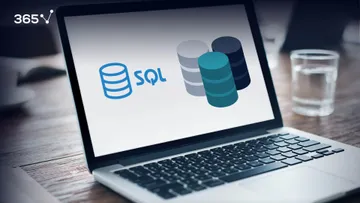There is a common misconception among beginner data scientists that data tables, databases, and Excel spreadsheets are one and the same thing! That is simply not true. Just like it’s not true that Excel and Google spreadsheets are the only form of tabular data you can work with.
In this post, we will focus on the key distinction between database vs spreadsheet. We will provide definitions for each of these data storage facilities and examine some common features. Before going on to outline what sets the two apart and why databases are inherently better for storing information.
This overview will be relevant, not only for current Excel/Google spreadsheet users but also for those learning Tableau or experimenting with SQL and Python.
Featured
- What is a Spreadsheet?
- What is a Database?
- How are Databases and Spreadsheets Similar?
- 3 Key Differences Between Database and Spreadsheet
- Pros and Cons of Databases vs Spreadsheets
- Database vs Spreadsheet: The Bottomline
What is a Spreadsheet?
It is an electronic ledger, an electronic version of paper accounting worksheets. It was created to facilitate people who needed to store their accounting information in tabular form digitally. So, it is possible to create tables in a spreadsheet. This is one reason some people believe spreadsheets and databases are interchangeable, while, in reality, they aren’t.
What is a Database?
As opposed to a spreadsheet, a database is a lot more complex. It is a collection of data organized and managed via structured query language (SQL). Most commonly databases are formatted in rows and columns, giving rise to the belief that they are identical to spreadsheets. But if we compare the data visualization functionalities of database software such as Tableau to the spreadsheets you find in Excel, this similarity quickly wears thin. Moreover, databases can vary in size tremendously from the smallest computer file on your desktop to giant cloud clusters. While spreadsheets are usually limited to a given number of cells.
How are Databases and Spreadsheets Similar?
Before we outline the key differences between a database and a spreadsheet, let’s look at some more similarities. Both databases and spreadsheets can contain a large amount of tabular data and can use existing data to make calculations. When using Excel these calculations are performed directly on the spreadsheet itself using formulas. For software such as Tableau, however, you need SQL integration to be able to effectively preprocess the information in your database and create new data. Neither spreadsheets nor databases are typically used by a single person, so many users will work with the same data in both cases. Beyond these two common functionalities, however, the data storage facilities we are discussing here differ enormously in every aspect of their practical use.
3 Key Differences Between Database and Spreadsheet
1. How Data is Formatted in a Database vs Spreadsheet
Ok. Imagine a spreadsheet. Every cell is treated as a unique entity. It can store any type of information – a date, an integer value, a string name. And then, not only can we have different types of values in various cells, but we can also apply a specific format to these cells.
This is not inherent to databases. They contain only raw data. Each cell is a container of a single data value. It is the smallest piece of information there is. You must pre-set the type of data contained in a certain field. This feature prevents inadvertent mistakes – for example, in a field containing date values, should the user try to insert a string, the software will show an error and she will have the chance to correct herself. This won’t happen in Excel – if you insert a string in the column with date values, you wouldn’t obtain an error message, and Excel will store the string value.
2. How Data is Stored in a Database vs Spreadsheet
In a spreadsheet, data can be stored in a cell, while in a database, data is stored in a record of a table, meaning you must count the records in a table to express how long the data table is, not the number of the cells. And that is it – you cannot pick a font color or size. All you care about is the information being stored; you don’t care about formatting. Our main goal is to save the numbers.
Once we’ve got our data properly stored in a database format, software like Tableau allows us to create stunning visualizations such as charts, maps, bars, graphs, and much more. Of course, spreadsheet compilers can also be used to visualize data, but the results are a lot less appealing.
3. How Calculations are Performed in a Database vs Spreadsheet
Another substantial difference is that, in a spreadsheet, different cells can contain calculations, such as functions and formulas. This means, that if you want to combine two integers, the result will be stored in another cell.
In a database, on the other hand, all calculations and operations are based on the existing data and are done after its retrieval. There is a specific feature, called “views”, similar to the tables, in which you can do a calculation. These objects also contain columns that can be normal columns like the ones in the tables or could contain a certain type of calculation. There is no way you can mistake a record of data with a calculation. To see an example of this, have a look at our tutorial on calculating totals in Tableau.
Pros and Cons of Databases vs Spreadsheets
1. Data Integrity
The database features mentioned so far improve data integrity – you can’t store different types of data in the same field, and it is unlikely someone will mistake a data value for an outcome of a calculation, especially in large data sets. Data integrity is a strong advantage when working with databases as opposed to spreadsheets.
2. Faster Manipulation of Data
Naturally, you might think a spreadsheet can contain multiple worksheets, so one can create tables in the worksheets, and then use the worksheets to create relations between the tables. Why bother using relational databases? Well, in a spreadsheet, such relations will be logically limited. Instead of setting up spreadsheets or worksheets, one can set up relations between the tables, and this will boost the performance of operations, increasing the speed with which you could manipulate your dataset.
3. Unlimited Volume of Data
Albeit powerful for many circumstances, spreadsheets have their limitations. Excel is incapable of handling over 1 million rows of data. This immediately induces us to look for a solution. Usually, the fix is to use databases, where having 2, 5, or 10 million records is not a problem. What might be more challenging is managing such vast swaths of data. But thankfully powerful integrations such as SQL + Tableau + Python allow us to handle even those.
4. Better Multi-User Experience
Referring to the multi-user property, spreadsheets are lagging. Essentially, every person must update their own spreadsheet with new data. For instance, if there is a new purchase to register or a last name in the “Customers” table to correct, every user must make these changes manually. You would justifiably think Google Docs and the latest versions of Office solve this issue, but they do so only partially. In Google Docs, you might have trouble finding out who changed or deleted information incorrectly, which often leads to a cumbersome situation where people have a hard time organizing their tasks.
5. Data Consistency
The database unlike a spreadsheet is a stable structure, controlling access permissions and user restrictions. One person can make a change that is visible to everybody instantly. This feature increases efficiency and data consistency when using databases.
6. Eliminating Duplicate Information
Considering data integrity and data consistency, using databases eliminates duplicate information, which is another way to save space and increase efficiency. Look at the “Customers” table. You know a certain first and last name corresponds to a unique email address. So, if you know John McKinley has changed his email and you are using a spreadsheet flooded with data, you may change the email address once and accidentally miss updating the same address in another record. This may lead to inadvertent mistakes. They can be avoided when using a relational database - an accredited user only needs to access the “Customers” table and change John McKinley’s email address there. Just once. Not only will this operation save time, but it will also anticipate inconsistencies.
Database vs Spreadsheet: The Bottomline
Everything we’ve discussed so far highlights why databases are a better environment for storing and keeping track of information when working with multiple dimensions and large amounts of data. While the database vs spreadsheet comparison may be heavily skewed towards the former, spreadsheets have their advantages as well.
In general, they are an excellent tool that allows us to carry out extensive analysis. But for the easy retrieval and updating of data, efficiency, data consistency, data integrity, speed, and security, relational databases are definitely the structure to opt for. They can store lots of raw data and are excellent when separating the data from the way it is displayed for analysis.
Finally, when we talk about displaying and visualizing data, we must also mention the powerful software Tableau. Set up your system and dive into our tutorials on topics ranging from navigating the program’s interface to creating interactive map charts.
Q&A
1. What is the Difference Between Databases and Spreadsheets?
Spreadsheets are electronic ledgers, i.e. electronic versions of accounting workbooks. While databases are collections of information organized and managed using structured query language (SQL). Aside from the difference in definitions, they are also used in completely different ways. Firstly, regarding formatting, spreadsheets format cells to fit certain values. You can apply formatting after you’ve put in the data and display it as a date, integer, percentage etc. With databases, you have to preset the values before input and if you attempt to plug information from a different kind into a field that’s been preset you will get an error. In terms of the way information is stored, the two also differ significantly – spreadsheets store everything in cells, while databases rely on records of tables. Finally, calculations involving values from two different cells are performed in a third cell when using spreadsheets. In contrast, in a database all calculations and operations are done within the table.
2. Is a Database Better Than a Spreadsheet?
In many ways a database is better than a spreadsheet. While spreadsheets are effective analytic tools, databases excel at facilitating retrieval of information, maintaining consistency, data integrity, speed, and security. Firstly, the chances of making a mistake when working with databases are lower because you can’t store different types of information within the same field. Databases are also much faster. Another great feature of databases is that they aren’t limited in the amount of data they store. Moreover, they provide a superior multi-user experience. Instead of every user having to update their spreadsheet with new data, changes made by one user in a database are instantly visible to all. Finally, because of this greater level of data consistency eliminating duplicate information a lot easier in databases compared to spreadsheets.
3. Is Excel a Database or a Spreadsheet?
Excel is not database — it is spreadsheet software. Even though many users try to force it to function like a database, its limitations in that regard are considerable. Starting with the most obvious, Excel is limited to 1M rows of data, while databases don’t suffer from such restrictions. In addition, when using Excel, you can apply formatting after you’ve input the data, and you can also input data that doesn’t comply with the preset values of a field. This creates prerequisites for mistakes, which the stricter organization of a database helps prevent. Aside from data integrity, maintaining consistency is also problematic in Excel. While a database allows multiple users to make changes on the fly, this is more difficult when using Excel. Moreover, with relational databases you can easily link between different tables, while working across worksheets in Excel can be cumbersome. Finally, the software is also much slower than a standard database, especially when processing substantial amounts of data.





